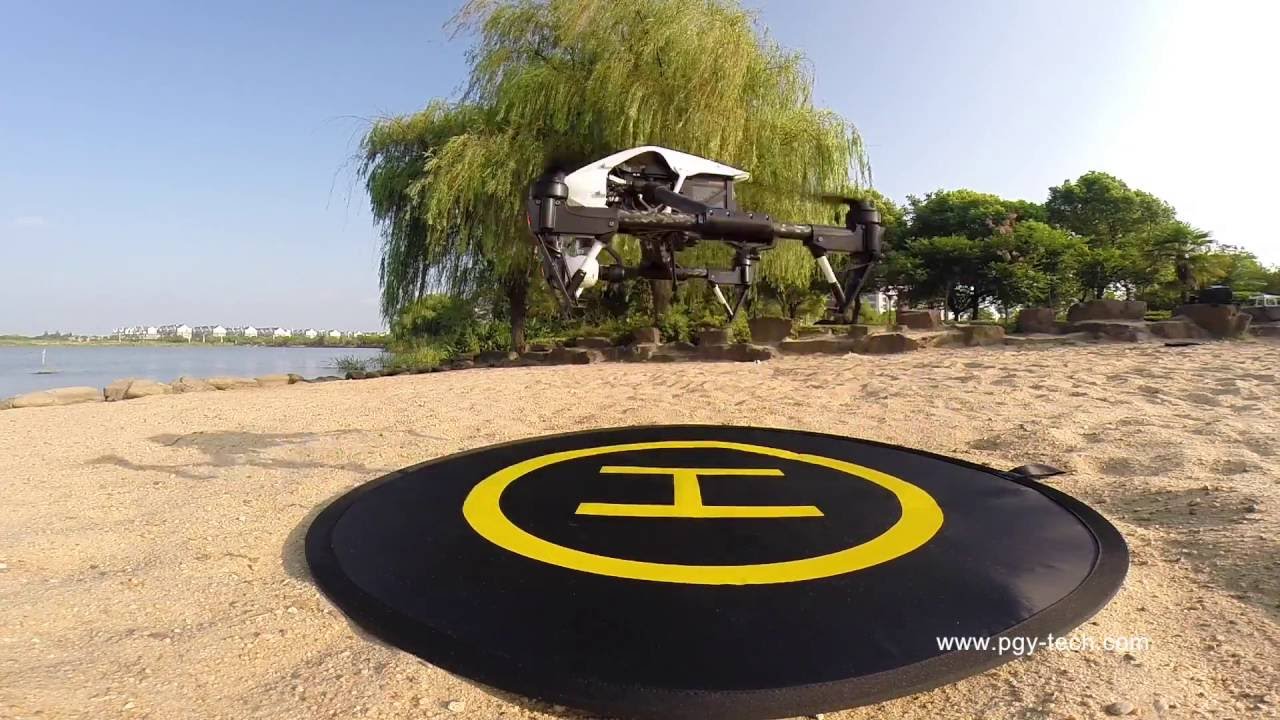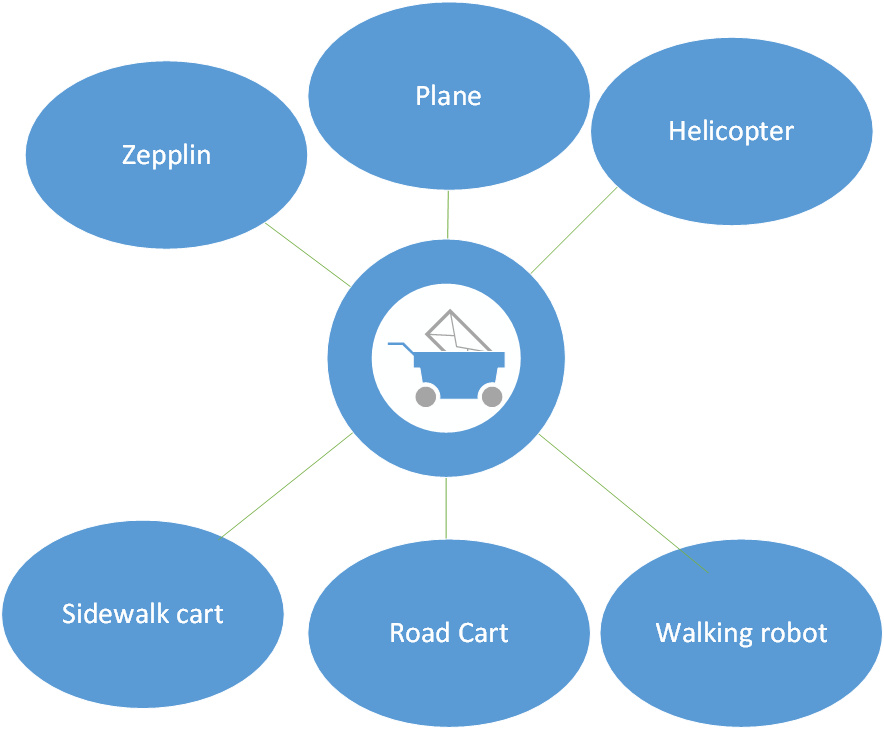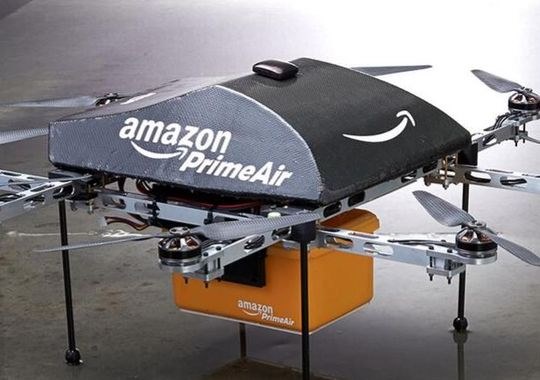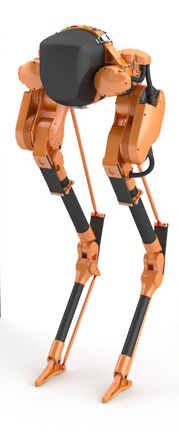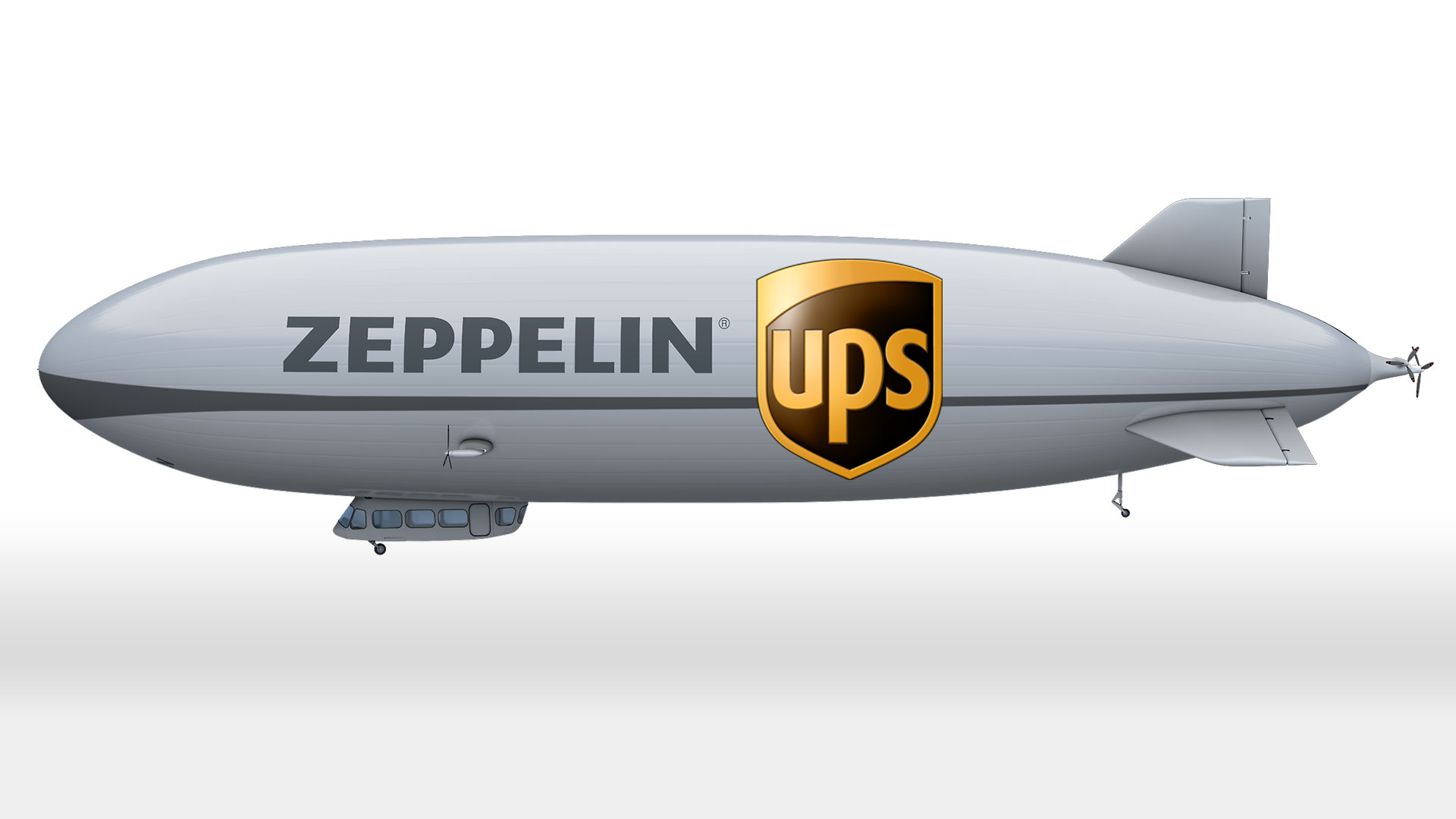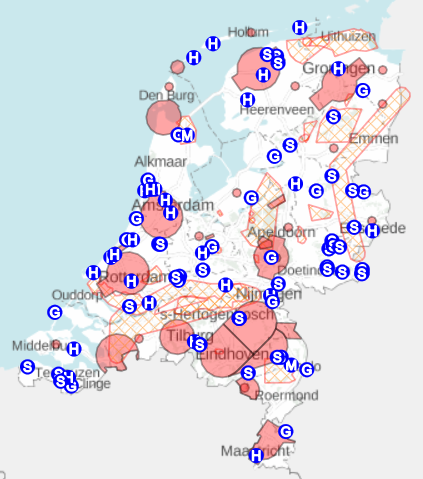PRE2016 3 Groep20: Difference between revisions
| Line 227: | Line 227: | ||
The costs of such a vehicle might be high, as it needs many sensors to observe its environment. Out of all these sensors the visual sensor are the most expensive as it needs both the cameras and computational power to process the images and locate all the obstacles. Also, the fact that many disposal stations will be required makes this system even more expensive. | The costs of such a vehicle might be high, as it needs many sensors to observe its environment. Out of all these sensors the visual sensor are the most expensive as it needs both the cameras and computational power to process the images and locate all the obstacles. Also, the fact that many disposal stations will be required makes this system even more expensive. | ||
==== Road cart ==== | ==== Road cart ==== | ||
Revision as of 16:08, 16 March 2017
Group members
Lotte Aerssen - 0892039
Wouter van den Bemd - 0948482
Lennard Kerkhoven - 0955882
Bjorn Walk - 0964797
Wouter Weekers - 0956095
Noud Schoenmakers - 0938197
Introduction
The current delivery systems that are available in the Netherlands are failing to deliver. There are three reasons that show it has to be changed. First the delivery times are too long, people and small businesses rely to receive their packages as soon as possible. However, because of dense traffic and crowded streets the orders take too long. Also in the ever changing society of today people are not bound to one location anymore. The society is craving for a system that delivers their packages on-the-go. Finally the the companies only deliver in a given time frame, thus the costumer needs to stay home if he wants to receive the package. This even fails because of the systems that are used by the companies where emails and apps fail to deliver.
These reasons show that the delivery system is in need of innovation. This report will elaborate the options on how to do so. Then one of the options will be chosen after an elaborate research and carefully taking the user in consideration.
User needs
In the ever changing environment of today, the customer and small businesses rely on the postal service’s fast delivery traject. However the future will need a faster, more reliable and more user centered traject of postal delivery. Therefore we want to develop a system that brings postal packages faster to the customers and does this in a diverse way where it will even be possible to order AND receive packages on-the-go. Thus it will not only be faster and more reliable, it will bring the user(customer) back to the center again with a system that introduces a complete new approach to the world of postal service delivery.
Approach
One of the goals of our system is that it tackles problems with regard to urban and countryside delivery of packages. This could feature a two way system. For instance, when the package needs to go to an urban environment, it could be delivered using autonomous busses. The delivery to the countryside could be done using aerial vehicles such as drones, airplanes, balloons etc.
Therefore the project will focus and investigate multiple possibilities of postal delivery services and it will not just focus on, for example, drones because there are numerous possibilities regarding the approach of autonomous postal delivery services.
Further, it is important that there is a possibility to grow for this project. For example, when designing a system that could be used for urban environments. One of the solutions could be a massive tubing system. This could make the delivery of postal services fast. However the we want a system that is designed for the user and around the environment of the user. Thus the city should not be designed around the system, the system should be designed for the city. This is an important issue since one of the goals is to make a system that has the ability to grow. Therefore it is important that it is diverse and impliable in every environment so that it could be possible to grow from city scale to a world wide system.
Boundary conditions
Some important boundary conditions are:
- safety
- weather resistance
- speed
- diversity
- sustainability
Ideas
The creation of a system with 'on-the-go' availability a system with a portable landing site could be used. To reach the customer when he is at the camping for instance, a portable landing site could be used for instance, such as the image below.
Options
There are a few options on how to design such a system. First, the system could go over land or by air. Both bring an their own drawbacks but also their benefits to the problem.
Differences between rural and urban areas
Urban and country delivery systems need a different approach when it comes to autonomous package delivery. Urban zones are high populated areas which contain many buildings which can be tall. Urban zones are usually located in cities or towns and contain many roads. Country areas are very different to urban zones because they have a low population density with fewer but longer roads of which some may be unpaved. High buildings are less likely in country areas but trees are more common.
Delivery system for rural areas
Delivery systems in rural areas preferably have a high travel speed as great distances are common. High speed wheeled robots that travel on the road and flying robots meet these requirements. Flying robots are preferable since they do not need advanced hardware to deal with other traffic. Another downside of wheeled robots is that the technology to take place in traffic is also not fully developed. Flying robots can travel easily over the often low buildings and trees in rural areas with a very low chance of having a dangerous crash with a person.
Delivery system for urban areas
In urban areas, a way to travel is preferred where the complexity of the environment does not affect the robot too much. Safety is also an issue, since it is a highly populated area. Slow moving robots are preferred because this makes collisions less dangerous. Legged robots or wheeled robots which travel on the sidewalk are perfect for this environment. Low travel speeds do not matter since travel distances are usually small in urban areas. The sidewalk is a relatively simple environment, which makes movement easier. Flying robots and high speed wheeled robots are not safe enough because the complexity on the road or in the air between the tall buildings makes it likely to crash, which is rather dangerous for such high speed systems.
Options for delivery
There are many different methods to move from point A to point B. One obvious method is by using wheels. Robots on wheels are well developed but they require pavement to function reliably and they cannot handle stairs. Travel speeds of wheeled robots are usually slow if they travel on the sidewalk where high speed motorized vehicles are not allowed. Driving on the road allows higher speeds, but the robot has to be equipped with more advanced hardware, thus raising the price. Another way to move is by using propellers to fly, which can be very fast. Important disadvantages are that packages cannot be very heavy, tall buildings have to be avoided and a crash in a populated area can be dangerous. Finally legs can be used to move from one location to another. At the moment legs are one of the most challenging ways to move around as a robot, since balancing on different surfaces can be quite a challenge. This way of movement is similar to the robots on wheels. The main difference is that a robot with legs can walk stairs and is less likely to get stuck on unpaved roads.
Helicopter
Pros
Diverse As helicopters are not affected by the quality and/or presence of roads they can be used in both urban and rural areas, making them very diverse and suited for all kind of environments.
Delivery at door
Helicopter drones are typically relatively small and can take-off and land vertically in a small space. This means that they can land (almost) everywhere making delivery at your door possible. The helicopters have no fixed delivery start and end point locations.
Shortest routes
Because helicopters can fly they are not restricted to the infrastructure. This means that they can take the shortest routes to your home reducing travelling time and costs.
Small chance of being damaged
As helicopters fly high above everything and everyone there is little chance of getting damaged. Helicopters are thus a safe way to make sure your package gets to its destination undamaged.
Fast
As mentioned before the helicopters are high above everything. Because of this they can travel at high speeds without risk of collisions, making delivery times faster.
Cheap
After the first big investment of buying the drones the costs are relatively low because they run on electricity.
Cons
Weight of package Because the drone needs to generate enough lift to lift the package the items can’t be very heavy or the drones need to be very large which takes away the advantage of door delivery.
Weatherproofness
A helicopter drone will typically be really lightweight. Because of this strong winds could cause the helicopter to swerve or crash. Other weather conditions like for instance rain could also cause the drone to crash as it limits the visibility of the sensors.
Restrictions
Nowadays there are a lot of restrictions on where drones are allowed to fly. This could make it hard for these vehicles to deliver packages everywhere. However, this problem could be solved by making new clear rules.
Small range
Currently drones have a small range due because flying uses a lot of battery power. This problem could be solved with better batteries.
Privacy issues
It is very likely that the helicopter drone will use some sort of camera to look where to land. When the drone flies over cities this camera can capture a lot of people giving rise to privacy issues. Also the use of GPS coordinates to locate where to deliver the packages can cause problems.
Failure can have large consequences
Because the drones fly at great heights with packages which can weigh up to a few kilos a failure could be a very dangerous situation. If such drone crashes onto someone this could cause great injury.
Plane
Pros
Diverse Planes are not dependent on the quality and/or presence of roads, so they can be used in both urban and rural areas, making the plane a very diverse option and suited for all kinds of environments.
Shortest routes In addition to the plane not needing roads to fly to the right destination, planes can take the shortest route through the air, reducing travelling time (and costs).
Fast Because planes will fly high above the regular traffic, they can travel at high speeds with little chance of getting into a collision. This would improve delivery time. However, if more and more of these delivery planes would fly in the air, there needs to be an aircontrol or plan or something to regulate traffic in the air.
Relatively cheap There needs to be an investment to start up, but after that, costs are relatively low.
Sustainable Ideally, the planes would run on a green current. This is beneficial for the environment in comparison with cars and trucks that are being used today.
Cons
No delivery at door, landing strip needed Because a plane is relatively unflexible when it comes to taking off and touching down, a landing strip is needed and it is hard to deliver packages right in front of someone's door. People would need to go outside and grab their package, which is inconvenient if people are in their pyjamas and/or the weather is bad. In addition, in the urban environment it is impossible to create a landing strip for every household or street. This is necessary, because the regular roads would be occupied by the regular traffic.
Available space The delivery planes are limited in packaging space. It is necessary to deal with this space in a strategic way. Do you chose for a couple of light, small packages, or just one big, somewhat heavier package. This choice is dependent on all kinds of factors (e.g., place of delivery), but we think it is possible for this to be dealt with through an algorithm.
Restrictions There are a lot of rules and regulations for drones. They would have to be adjusted for a plane to deliver packeges to customers.
Privacy issues It is very likely that the plane will use a camera or some other sensor to initiate and control the landing at the right time and space. This camera would also capture surrounding environments and probably people as well, which could lead to privacy issues.
Failures can have large consequences The risks of something going wrong is smaller than with a car, but the consequences can be larger. If a plane crashes and hit people in their way, it could be life threatening.
Walking robot
Pros
Diverse Cassie is dependent on the road and his environment, but because is can walk everywhere and stay stable he can walk almost everywhere where also a human can walk.
Privacy Because Cassie walk on the sidewalk he does not effect any privacy as just a human would do when he/she walks on the sidewalk, therefore the privacy remains the same.
Door to door Cassie can deliver door to door because he walks on the sidewalk which is connected with the houses.
Sustainable Cassie uses electricity which can be green electricity so that he is sustainable .
Cons
expensive The investments are quite big because cassie is not fully operational yet and has some hightech stuff in it what costs alot. But after these investments the maintenance of the robot is not that expensive and it will outweight the costs of devilery at the moment.
Available space Cassie is limited in packaging space. It is necessary to deal with this space in a strategic way. Do you chose for a couple of light, small packages, or just one big, somewhat heavier package. This choice is dependent on all kinds of factors (e.g., place of delivery), but we think it is possible for this to be dealt with through an algorithm.
Restrictions The rules need to be made about the use of autonomous robots for delivery.
Slow Because it walks at human speed the robot is kinda slow in comparison with cars or planes, so for long distances there still is a another vehicle needed to get the package in a decent range so cassie can be used.
Sidewalk Cart
Description
This vehicle moves packages from point A to point B using the sidewalk. It has various sensors to avoid collisions with obstacles or persons and it is able to use GPS to move itself towards the destination using wheels. The packages these robots can carry can be quite heavy, however, the volume of a packet will be limited. This is because the robot has to be able to avoid obstacles on the sidewalk, which cannot be done if the dimensions of the cart including the package are too big. The movement speed of the robot will be about the movement speed of an average pedestrian.
Effectivity
A small delivery unit that travels at the speed of an average pedestrian which is about 5 kilometers an hour is very slow. This makes the robot only effective in a small range around the package disposal station. For covering large areas, a lot of disposal stations have to be placed and these disposal stations also have to be supplied with goods. This is fine for small systems where only one disposal station is required, for example a pizza delivery service. The products will then be produced and disposed at the same location. This removes the struggle of filling the right disposal stations with the right products which makes the process much more slow because of the extra step in the transport process and therefore less effective. A system like this would only work well for small areas with a dense population. There can be concluded that the system will be effective in urban areas for local companies and less effective or even obsolete for greater delivery areas or a rural area with a low population density.
Reliability
Reliability is an important factor for a delivery system. Small delivery robots can be very reliable under the right conditions which leads to a trustworthy delivery system. Sidewalk carts are very unlikely to damage the package. This is because it moves very slow and stores the packages in a safe inside the cart, which in the uncommon event of an collision prevents damage to the package. The robot however has a chance to get stuck by for example driving on uneven terrain. The robot will be able to notice that it is stuck and send a warning to the central station, where a human controller can try to unstuck the robot. In an event of hardware failure, the robot will also be rather safe, as the robot moves very slowly. The central station will be notified since the robot does not move. A repair mechanic can be send towards the robot to fix it, which causes a slight delay in delivery time but no damage to the package
Safety in traffic
A sidewalk cart only participates in a few ways in traffic. First of all it must be able to safely walk on the sidewalk using its sensors to avoid obstacles and humans or pets. A collision with a person will be very unlikely because distance sensors can check whether there is an object in from of them and then automatically stop moving. Therefore the only real threat is a human or vehicle which bumps into the cart, which can be more dangerous. Also, the robot must be able to cross a road, which is more complex than walking on the sidewalk, as it has to recognize whether it is safe to cross, taking different traffic into account and their different roles and speeds. This can become quite challenging but autonomous cars by Google have proven that autonomous driving is possible. This also includes an extensive monitoring system which can determine where every traffic participant around the vehicle is located and which speed it has. The question however is how much a sidewalk cart can monitor as it is such a small vehicle.
Abuse of the system
Stealing packages, destroying the equipment or stealing the robot as a whole are all forms of abuse. A sidewalk cart will be a very vulnerable vehicle, as it moves slowly and it is not that heavy due to its maximum size. The robot will need some sort of package protection safe which can be opened using NFC on the smartphone of the customer. To prevent stealing the vehicle as a whole, anti-theft features should be implemented. This can be done by using the tracker that is already in the robot, or by using a loud alarm which goes off once the robot is lifted up or damaged. This should also immediately send a warning message to the staff of the delivery system who can warn the police if it is necessary.
Costs
The costs of such a vehicle might be high, as it needs many sensors to observe its environment. Out of all these sensors the visual sensor are the most expensive as it needs both the cameras and computational power to process the images and locate all the obstacles. Also, the fact that many disposal stations will be required makes this system even more expensive.
Road cart
Description
This vehicle delivers packages by traveling over the normal roads cars use. Because of this the road carts are much like the delivery vans that are used today. However there are a few differences to make it an autonomous delivery system. Firstly it drives completely autonomous. To make this possible it has to have a lot of sensors, GPS and AI to make decisions. Secondly the unloading of the package is also done autonomously. Due to its large storage area the road cart can carry large and heavy items. The road cart can travel at the same speeds as normal delivery vans can.
Effectivity
As said before the road cart is basically like the vans used today. This makes them effective in a large range, because they can travel at high speeds. Also the large storage space the vans have makes it possible to take a lot of packages in one run. This however introduces another difficulty namely the one of taking the right package at the right location. However there are already systems that can do this, making the road cart an option for both rural and urban areas.
Reliability
To be reliable the delivery vehicle has to be able to deliver the package safely and on the scheduled time at its destination. Road carts travel by the roads between the normal traffic. This makes its arrival times uncertain as there are a lot of things that can delay the vehicle, such as traffic jams or crashes. Another problem is possible damage to the packages. Because the storage room of the vehicle is large there is a lot of room for the package to move around when taking turns or crashing if it is not tightened secure enough causing possible damage to it. Also, when having either a software or a hardware failure the autonomous cart can become a dangerous projectile as it can travel at high speeds making safety an issue.
Safety in traffic
The road cart participates in the busy traffic on the roads. Therefore it has to have sensors to prevent collision. This technology is already used by for example Tesla for the autopilot function, so this should not be a problem. The only problem is thus when another vehicle crashes into the cart, but this is a problem all vehicles on the road face so there is no reason this should be the reason not to choose this option compared to the vans used today.
Abuse of the system
A road cart will not be very vulnerable to abuse, because it will most likely be the size of a normal delivery vehicle so it cannot be picked up like for example the sidewalk cart. The road cart can also be locked automatically when no package is getting dropped off. So abuse of the road cart will not be a big problem.
Costs
The costs of the road cart might be very high as it needs a lot of technology to make sure the package gets delivered safely, but with the rapid growth of technology these techniques will get cheaper.
The zeppelin
Description
One of the options is to make the system by using a zeppelin. It will take the packages from A to B through the air. It will use GPS to know its location and use some sort of engine to propel itself through the sky.
Effectivity
One of the options of a package delivery system is to take it to the sky and using a zeppelin to do so. While this option seems outdated it has some advantages that other technologies still not have overcome:
For instance, safety. When a zeppelin is struck by something and the gas flows out of the balloon, it drifts towards the ground on a slow manner. In comparison with a heavy helicopter or plane this is a great advantage.
Next, the lift force. A zeppelin can easily be adjusted to have a high lift force. The addition of light gasses make it possible to take heavy objects to the sky. This is a big difference with other aerial options.
Also the power consummation is much lower on a zeppelin, the balloon requires no to low additional energy, the balloon floats around. The only consummation of power is the way it propels itself through the sky using, for instance, propellers.
Reliability
One of the big drawbacks of a balloon based system is the speed of it. These means of transportation are not known for their speed. On the contrary, it is a very slow. Also since it is so big it is an object that can be easily hit by other objects and even damage wildlife when birds fly into it. Also the low weight of the zeppelin makes it very sensitive for winds and other weather influences.
Safety in traffic
As described in the Effectivity, one of the advantages of the Zepplin is the safety. The balloon will never fall as a brick from the sky due to the slow gas flow out of the balloon. This gives the citizens more time to get clear of the falling object. Also won't the impact be high due to the slow speed of the falling object. However, due to it's size it is big enough to be hit by something and what happens when the zepplin crash lands on the high way. This could lead to crash of traffic due to it's size.
Abuse of the sytem The zepplin is a system that could be easily abused. Simple teenagers with a blow dart could even be the reason the zeppelin could crash. This one of the problems with the development of the system because the material should not be easily penetrable but still lightweight. Then, when the zeppelin has crashed the safety of the package has the same problems as all of the devices: how to keep them locked up. Here the zeppelin is in the advantage because of its lift force, a safe could be mounted under the device making it less easy to break open. Also the size of the object makes it hard to be taken away.
Costs Since there is no company that has ever produced a prototype where a balloon technology is used to deliver packages it is hard to determine the costs. One way to estimate it is using the costs of blimps and scale them by lift force and then do so by the price as well. The Skyship 600[3] for example could lift roughly 2300 kg. Since the aimed packages are 2 kg the blimp can be scaled down by 1000. This gives a device with 6 m^3 of gas, thus roughly it would be 3x2x1 m. The costs of the blimp whould therefor be around $15.000,-. Since the original costs $15.000.000,-[4]. Still since this smaller blimp would ask for less expensive engines it could come cheaper. Also the Airship 600 features a cabin for crew and passengers. Still it is an estimation for the costs to develop such device.
The choice
The current situation
Rules and Regulation drones (Netherlands)
There are no clear rules for autonomous drones stated in the legislation of the Netherlands, therefore the rules for professional use will be used as rules for the autonomous drones. In the legislation drones are divided in light drones which weight up until max 4 kilogram takeoff weight, and heavy drones which weight up until 250 kilogram takeoff weight. For packaging drones the focus will be on the light drones. The drone always need to give priority to all other air- and land-traffic when they are approaching. They also need to fly in daylight and may not fly in the dark. The drones may not fly higher than 120 meter and need to have a minimum distance from crowds, compact building density, artworks, harbors, industrial areas, railways, public roads, vessels and vehicles of 50 meters. There are also No-Fly-Zones in the Netherlands were no drones are allowed to fly. As you can see are the No-Fly-Zones mainly in big cities and airports. The red area's are the the No-Fly-Zones for the drones.
The package delivery
The package delivery system can be separated in several steps. One of the biggest delivery companies in the Netherlands is PostNL. A description of a possible package order process looks like this.
1. When a client orders a product from a web shop the web shop sends the product, from its own stockroom, in a package to a sorting center of a delivery company.
2. In the sorting center all the packages that need to be delivered in a certain region in the country are gathered.
3. When there are enough packages to fill a vehicle (van or truck) the packages are transported to the right region and delivered to a pickup point.
4. The clients can check if there package has arrived at their pickup point and can pick their delivery up when they have the time for it.
For an autonomous delivery system the last step in this process is the most interesting. If there is an autonomous system that delivers the packages from a pickup point to the clients home it would save them time. This is especially true for areas where the density of pickup points is not so dense and clients would still have to travel some time to receive their orders.
The different price classes
The way the shipping cost of a package is determined depends on the weight of the package. Usually there is also a maximum size of length and width that the package needs to have. Lastly the shipping cost can be increased if it is requested that the package gets send with urgency. The price classes, based on weight, of PostNL for example are divided like this: [2 kg], [2-5 kg], [5-10 kg], [10-20 kg], [20-30 kg].[2]
The Main Stakeholder: PostNL
The main stakeholder of autonomous delivery systems is PostNL. PostNL a large post office in the Netherlands. In the Netherlands there are several other post offices that are in direct competition with PostNL. In order to move on with this competition it is necessary to deliver the packages and letters as efficiently and fast as possible, in order to meet the demands of the customers in the best way. Because the package delivery is growing in a fast pace thanks to the online shopping behavior of Dutch consumers [5]. PostNL has the biggest market share (50-60%) in the package delivery sector in the Netherlands [5]. For these reasons this sector is the most interesting for PostNL to invest in an innovation such as an autonomous delivery system.
PosgtNL current situation
In the current situation PostNL does not use any autonomous vehicles for the transportation of the packages. The package delivery proses has these following steps:
1. The client makes an order on a web shop
2. The package gets send from the web shops stockroom to a sorting centrum
3. The package is processed in the sorting centrum
4. The package is send to a pickup point close to the clients home
5. The client picks the package up from the pickup point
PostNL has 6 sorting centers in the Netherlands [6]. From these centers the packages are transported to the pickup points with large trucks. If the customer demands that the package is delivered to their house directly, the package is transported with a smaller van directly from the sorting center. Because of the low number of sorting center these vans usually have to traverse long distances and transport a lot less packages. In this process PostNL delivers 500.000 packages a day, during heyday this can increase to 1 million [7]. The pickup points in step 4 and 5 of the process are spread across the country, but in the more populated areas there are a lot more pickup points than in the smaller villages. In 2015 there were around 6,8 million people in the Netherlands that live in the big densely populated cities and around 6,5 million people on the rural eras. The rest of the population lived in a transition area between urban and rural [8]. The people that live in the urban areas do not have to look far for a pickup point and because the pickup points can provide for many customers in the neighborhood this is perhaps the most efficient way. But especially for the rural population the pickup points have to sustain customers spread over a large surface. Because there are still a significant amount of people living in these areas it is worth to improve the services in these areas.
Right now if customers choose to have their package delivered to their front door, the vans of the delivery company have to send a van with a very limited package capacity to an area where several customers expect an order. The van has to take the most optimal route to deliver the packages. The points in this process that an autonomous delivery system can improve are:
- costs of delivery employer
- costs of fuel for the van
- speed of delivery
- efficiency of delivery
References
[1] The self driving delivery robot, visited on the 8th of March 2017, visited from: https://www.washingtonpost.com/news/innovations/wp/2015/11/02/this-self-driving-delivery-robot-is-coming-soon-to-sidewalks/?utm_term=.3677b2f3536e ;
[2]The current prices for postal delivery, visited on 8th of March 2017, visited from: https://www.postnl.nl/tarieven/tarieven-pakketten/ ;
[3]The airship 600, visited on 16th of March 2017, visited from: https://en.wikipedia.org/wiki/Airship_Industries_Skyship_600 ;
[4]Costs of the Airship 600, visited on 16th of March 2017, visited from: http://www.newsday.co.tt/news/0,153096.html ;
